Original Author: Hongyu
Original source: Fire Phoenix Capital
STEPN is an NFT mixed reality chain game in the "move to earn" mode. The game won the fourth place in the fourth IGNITION Hackathon game project of SolanaVenture.
In the game, players can purchase NFT running shoes and import them into the APP for daily running mining activities. Their NFTs can be purchased in the marketplace on Magic Eden and APP; the demand is strong, the floor price reached 7.88 SOL (February 18), the price is relatively firm, and the GST is also rising steadily.
The project has recently completed a US$5 million financing led by Sequoia India and Folius Ventures. Solana Venture, Solana Eco Fund, an official Solana-backed investment institution, and Alameda, a market maker, all participated in the investment. In addition, there are also funds such as Spark Digital, and Huofeng Capital. Also participated in the KOL round as one of the consultants.
Personally, I think that the gameplay of STEPN, a social game, comes from the game mechanism design on the one hand, including internal economics, gradual mechanism and reproduction mechanism. Driven by realistic scenarios, it has a high capacity for C-side logic.
secondary title
flat top box with lock
By reviewing the development history of Louis Vuitton, it may be helpful to understand the future of STEPN.
LV started from the 1840s to the 1990s, and three factors played an indispensable role in it:
The birth of tourism
Diffusion of steam engines
gameplay innovation
In 1837, the founder left his hometown on foot and went to Paris as an apprentice in the studio of luggage maker Monsieur Maréchal, mainly responsible for helping customers pack their luggage.
At this time, it has been about 115 years since Thomas Savery invented the first commercial steam engine, and steam engine technology has been widely used. The Savery steam engine solved the mine drainage problem, and then Newcomen improved it, and the steam engine was widely used in the mining industry; after more than 100 years of technical iteration, the steam engine has spread from the mining industry to all industries related to production and manufacturing, including Transportation industry.
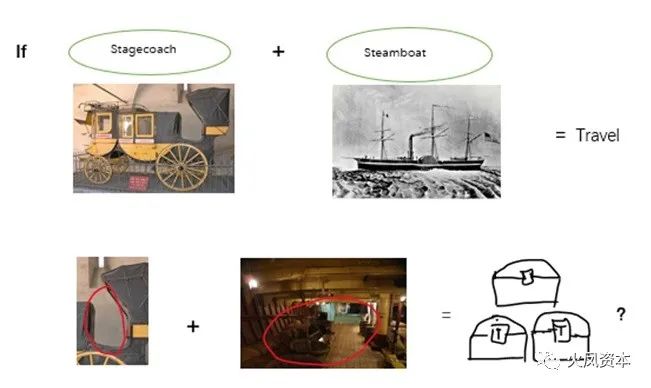
At that time, trains and ships had already appeared in the lives of Europeans, and Stagecoach also took on a large number of long-distance travel needs. However, the iteration of living facilities is still lagging behind; obviously, the design of the dome box is not suitable for scenes that require a large number of suitcases to be stacked and sorted. It can only be placed in a single row. Underutilization.
In 1841, Thomas Cook chartered a train to transport up to 570 people from Leicester in the English Midlands to Loughborough for a temperance convention. The round trip is nearly 18 kilometers, the group charges 1 shilling per person, free lunch and snacks with ham, and a band singing hymns to follow. This is recognized as the world's first commercial tourism activity.
Thomas Cook's move is regarded as the beginning of the modern tourism industry - the tradition of "Grand Tour" (Grand Tour), which was originally enjoyed only by the European aristocracy and the rich, began to spread to the common people, and tourism became cheap, safe and comfortable , open to everyone, travel in different places has gradually become a high-frequency scene. The commercial tourism scene contains many new needs that have yet to be tapped:
Keep property safe
Portable and easy to stack
Good for packing
………
These needs exist widely among tourists of all walks of life. The emergence of commercial travel has made the above needs more intense. There may be many compromises to meet them, but people need a more reliable and simpler solution.
At the same time as commercial travel appeared, Louis Vuitton had also ended his 17-year apprenticeship. He entered the French royal family as a bundler and helped Queen Eugénie de Montijo pack her luggage. Soon, Louis Vuitton went to sea to start a business and invented the world's first flat-top suitcase (Flat Trunk). This suitcase uses waterproof canvas as the outer skin, and the poplar wooden frame is shaped. It is lighter and easier to carry than the traditional dome suitcase. Stacked shipments are popular with travelers:

image description

Louis Vuitton Steamer Trunk WardrobeTrunk Chest France,circa 1920, the case can be purchased on chairish.
With the support of explosive models, in 1859, LV opened in Asnières. In 1886, the successor Georges adopted a single lock system with two spring clasps, and LV's luggage products were basically mature.
Safe, portable, and convenience-based industry insights. LV has survived for more than 170 years until today.
This is a very good portrait of the founder, with both bottom-up and top-down industry perspectives, whether it is the luggage packing needs of ordinary people, or the luggage packing needs of the rich, nobles, or even the royal family, there will be deep insights . LV has grasped the two core requirements of "safety" and "portability" and has grown steadily.
From the development of LV, we can intuitively feel that the cold start of the brand does not depend on "tonality" from the very beginning, but is based on new scenarios, starting with strong use value and new solutions, and every penny Divide the goods, and then gradually iterate to a higher level of demand.secondary title
A running shoe that breeds and upgrades
Obviously, Top tier brands all have new prerequisites that are different from the old scene:
LV: steam engines, ships and trains
Stussy: transistor, color TV, hippies, reggae, street culture
To sum up, the first layer is technological progress, the second layer is the use case of technological progress, and the third layer is the scene, or the new gameplay of the use case. For example, the steam engine is the first layer, the second layer is the use case of the steam engine-trains and ships, and the third layer is what to do on the trains and ships. This is a new way of playing.
Whenever technology makes certain needs cheaper, non-value productive needs will quickly become the main contradiction. Boats and trains gave birth to recreational travel, television and black music made street fashion a true cultural phenomenon, and these factors laid the foundation for the birth of a new way of life
StepN also dances like this, you can think of it as a composable gameplay:
smart phone
game
game
Concept of exercise and health
………
The key difference here is that without the cryptocurrency, STEPN has no soul and becomes an ordinary running app. There are many homogeneous sports and health apps. According to the law of WEB2 winner takes all, those that should be disbanded have also been disbanded, and the remaining ones are all wonderful, forming their own data-traffic-capital moat.
Ernest Adams once mentioned:
The game industry divides games into different types according to their playability. The playability of some games comes from internal economics, some from physical mechanisms, and some from level progression and social interaction.
The interesting point of STEPN is the gradual mechanism and internal economics. The former represents the inevitability of getting started. Users know that it is running and exercising, and it is easy to get started without understanding too many complicated rules; while the latter is Tokenomics Driven means whether the user can continue to run.
Summarize STEPN’s gameplay design from the player’s perspective. The core scene is running, the entry ticket is to buy sneakers NFT, and the incentives are $GST and NFT. The motivation of players to run is driven by health needs and profit-making needs. The positioning here is very differentiated:
Compared with chain games: low barriers to entry, not only incentive-driven, but also healthy
Compared with Defi: not only APY-driven, but also game-like
Compared with ordinary running and walking: you can move 2 earn and get rid of boring
………
Co-founder Yawn once mentioned in MableJiang's podcast that when they started their business, they found that they entered the field late, so they chose the track of Move 2 earn
The game itself is not a very good direction, but the gameplay is very good. We hope to make a product with good gameplay in it, but it is not a game
The gameplay of STEPN is roughly like this. Players need to buy running shoes as an entry ticket, and then just tap "Start" on the interface to start the game. The entrance is very similar to most small and beautiful applications in WEB2.
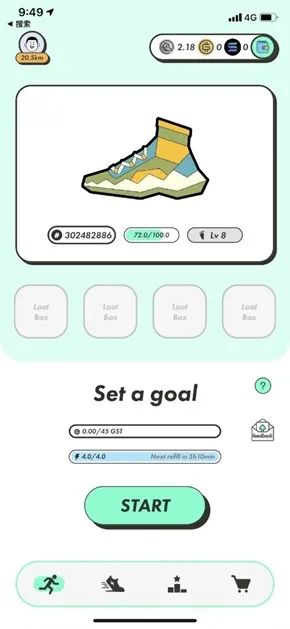
There are 4 types of running shoes, namely Walker, Sneaker, Jogger and Trainer. The starting level is 0, the energy limit of a single shoe is 2, the green shoes of the collection level are 3, and the purple shoes are 4; different types of shoes, running/ The upper limit of walking speed is also different; the initial upper limit of $GST earned per day is 5, the upper limit of energy can be increased by purchasing shoes, and the upper limit of earning by playing can be increased by upgrading. The following is a comparison table of shoe types and basic returns in the white paper
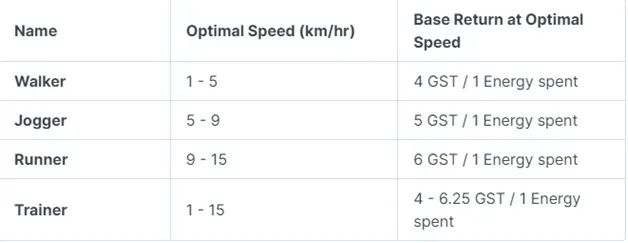
According to the upgrade rules, if a Walker wants to upgrade from level 0 to level 28, the GST it needs to spend is the accumulation of 1 to 28, of which level 5 (10GST), level 10 (30GST), level 20 ( 80GST), so the cost of upgrading to level 28 is about 491 GST, and the cost of GMT from level 28 to level 30; every time you level up, you can get 4-12 points to increase attributes, which are divided into four items:
Efficiency: Determine how much GST/GMT a unit of energy can earn
Luck: Determines the drop probability of the treasure chest
Comfort: Determine the Buff probability
Resilience: Determining Repair Costs
These are all $GST consumption scenarios. When the author's Walker reaches level 7, the repair cost is maintained at about 0.4 GST/1 Durability, and 4 energy per day can earn about 14 GST. Theoretically, players can choose a variety of strategies to maximize profits:
Focus on adding Efficiency and Resilience skill points: This can make your shoes' earning efficiency grow at about twice the speed of each level, and it can even become 4 times when you encounter an activity week that doubles the energy of sneakers. But your treasure chest drop rate and BUFF probability will be very low
Focus on adding Luck or Comfort skill points: this is suitable for gamblers, not the above introversion strategy, but luck will become very good
Give up Luck, mainly add the skill points of Efficiency, Resilience and Luck: take into account both introversion and luck
……
This is just the basic strategy for STEPN to upgrade and add points. Many people’s gameplay is actually more clever. For example, buy 10 pairs of sneakers at one time, quickly spend money to upgrade to level 5, and then pair them with new mint sneakers. A pair can be produced every day for five days. In the end you will have 15 pairs of shoes.
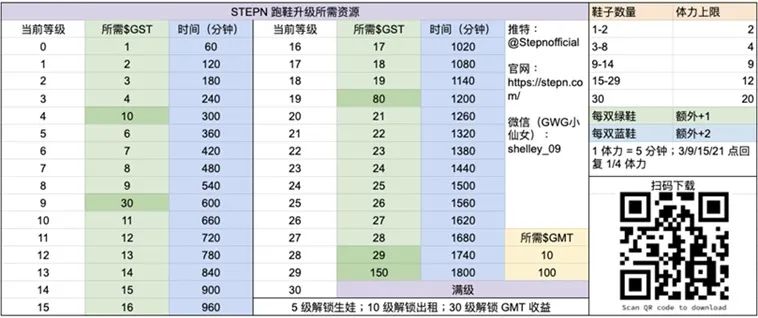
If you want to continue running, assuming that among the 10 pairs, 6 pairs are Walkers, 3 pairs are Joggers, and 1 pair is Runners, then the total amount of energy that can be consumed in a day is 20, and the upgrade cost is about 200GST. If Runners are used as the main shoes , ideally, the daily income can reach about 120GST. Of course, the amount earned is not fixed, it is a parameter range, and there will be tides.
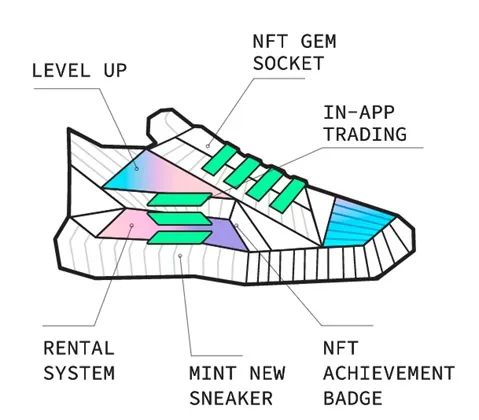
Seeing this, it is actually obvious that STEPN is very different from Yuepao and Qubu. Yue Pao is a standard mobile Internet social application, which has nothing to do with tokens. It is also affected by compliance and technical architecture. Enjoy the capital premium of token appreciation; Qubu is a CX application for crazy rushing towers.
The future of STEPN is not actually the penetration rate of sports and health users among encrypted users, or the penetration rate of directly copying sports and health apps. Rather, a pair of NFT sneakers that can make money. It mainly depends on whether you agree that this is a new scene:
Encrypted users face the computer for a long time and need to exercise more to stay healthy
For non-fitness enthusiasts, exercise is boring and requires external motivation
The incentives recognized by Crypto Native must include FT and NFT
Non-fitness enthusiasts are more users outside the circle, they are used to using apps
………
There are many hidden requirements, such as
It is difficult for outsiders to enter the encryption rabbit hole, and a holistic change in user habits is required
Most users in developing countries use mobile phones instead of computers to access the Internet, and need to adapt to mobile terminals
Whether it is shoes or sports, the core of STEPN is strong scene binding. Not to mention the $GST difference

NFT has simple and easy-to-understand usage scenarios, and the advanced gold mining strategy has strong scalability. The low-carbon and healthy value orientation meets the mainstream ideology and self-improvement needs. It is difficult for players to simply seek rent through mining and selling, and the return on assets is implicitly limited and diversified.
The appeal of the users and value brought by this is not purely gold-oriented; it actually solves the previous problems of chain games to a certain extent, and helps to prevent the game from falling into a death spiral in the bear market, which is precisely what most The biggest hidden danger faced by blockchain games.
As an investor, I saw a lot of chain game projects last year, but I still have a skeptical attitude towards most of them:
How is it different from gamified Defi? The scene is very homogeneous, which means that they are all rushing to encrypt native users, but the volume of APY is not as high as that of Tugou Mine
Where is the gameplay? To be honest, they are all games in the Pre Demo stage. The design ideas are patchwork, most of them have no narrative, and there is no fun at all. You can only stare at the screen and modeling. There is no hope for users outside the circle to buy
The gameplay is not good enough, the design of DAO and revenue structure is also very rough, the use cases of tokens are single and homogeneous, and only simple and rude methods can be used to prevent mining, withdrawing and selling, and lack of in-depth consideration of ecological stability; these games are large Most of them can only be neglected and die slowly. A smart woman can't cook without rice, and even the best marketing can't solve the problem of bad products.
Whether STEPN can continue to conquer cities and territories still needs to be observed in a longer dimension, which depends on its brand and community style of play, whether it can make the project a unique supply; it also depends on whether the scenes it puts can spread, Advanced as a recognized new way of moving, resulting in a new brand identity:
Crypto OG does not use Keep or Joy to run, but uses STEPN
In the end, I think STEPN is an exploration of the future of on-chain applications. It raises two questions worth thinking about:
Whether it is Gamefi or social networking, do on-chain applications need to find more unexplored application scenarios?
In order for more people to enter the crypto world, do solutions to real world problems need to be proposed?
References:
“Your take rate is my opportunity”
References:
Folius Ventures Research Report: Game Feature: Founding of a Nation – From Slavery to Independence